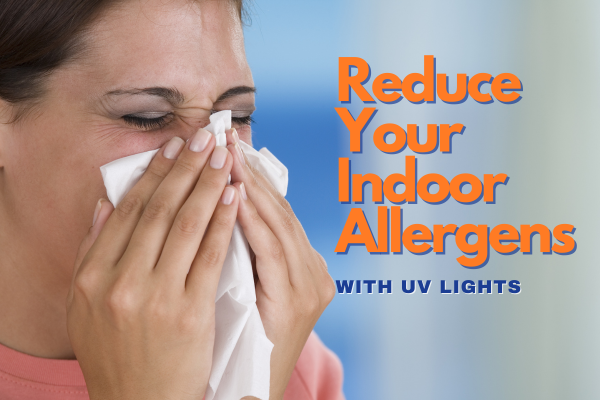
Sneezing, sniffling, and itchy eyes are all common reactions to outdoor allergens, and they change from season to season. But if you still notice those same allergy symptoms inside your home, you may have a problem.
Your indoor air should provide a respite from outdoor allergens, but if your living spaces have pollutants in the air, you won’t find any relief from respiratory issues.
Let us shed a little light on the subject.
Of course, if you’ve tried to reduce indoor allergens before, you know that it’s a task that’s easier said than done. When properly maintained, filters in your HVAC system are effective up to a point. However, even the best filter lets a large number of allergens and pollutants through to recycle back into your air.
Does that mean you’re doomed to a home full of indoor contaminants that affect your air quality? Thankfully, the answer is no. There’s a solution that’s been around for a while, but many homeowners aren’t aware of: ultraviolet (UV) lights. Here, we’ll explore how UV lights work to reduce allergens, how you can start using them, and what you need to keep in mind to maximize your allergy relief.
Ultraviolet lights have been proven to be very effective against many different airborne contaminants and common allergens. They are typically installed inside the ductwork of a home or as a standalone UV air purifier, and they work in two ways to improve indoor air quality:
First, air containing various contaminants moves through your ducts or the purifier and passes the rays of UV light. The lights alter the DNA and RNA of the contaminants. This weakens the contaminants so that they’re no longer able to grow or reproduce and die off quickly. In addition to disinfecting the air from outside pollutants, ultraviolet lights can also help eliminate the natural growth of mold on your HVAC coil and drain pan.
While studies have shown that UV lights are effective in killing off biological particulates like dust mites, the full efficacy of ultraviolet radiation in the home is still being researched (just like the efficacy of using indoor plants for air quality). While we don’t know the exact amount of airborne allergens UV lights can remove from the home’s air, we do know it reduces mold spores and particulate matter, which can improve the energy efficiency of your HVAC system and lengthen its lifespan.
Before we dive into the types of UV lights designed for HVAC systems, it can be helpful to understand what UV light actually is. Ultraviolet or UV radiation is emitted by the sun and filtered through the ozone layer in three types of waves: UVA, UVB, and UVC.
When it comes to HVAC systems, there are two types of UVC lights primarily used:
Placing UV lamps inside your ductwork can be effective, but there are several factors you need to consider before deciding whether to adopt a whole-house approach to UV sanitation:
There are numerous upsides to adding UV lights to your HVAC system, including:
While the benefits are indisputable, there are also several downsides to keep in mind before deciding to install UV lights:
There is no “set it and forget it” option when it comes to installing whole-house UV lights in your HVAC system. To ensure you get the maximum benefit from your lights, you’ll need to complete the following routine maintenance:
You should plan on replacing the UV lights in your HVAC system once a year, but there may be times they need to be replaced outside of that schedule. Consider changing out the HVAC bulbs if you notice any unpleasant, mildewy odors in the home, if you feel that your allergy symptoms have gotten more severe inside your home, if you see mold growing on your evaporator coil or in the ductwork, or if you see noticeable damage on or around the bulb.
Some homeowners are concerned about the safety of ultraviolet lights. While UV rays from the sun can be damaging, UV air cleaners are installed inside ductwork where they don’t come in contact with your family. UV lights don’t use chemicals or produce ozone, so they’re a safe method for removing indoor allergens.
When inspecting or replacing bulbs, make sure to always wear protective gloves and glasses, and never come in direct contact with the bulbs.
By themselves, both UV air cleaners and properly maintained filters can help remove allergens from your home. Used together, they’re even more effective for getting the indoor air quality you need.
For more information about UV lights or other HVAC concerns, check out our Essential HomeCare plans and find the right fit to stay on top of your HVAC maintenance and ensure you can always breathe easy with Airtron!